Source: Palestine Refugee Research Net, June 1997
The conflict between Israel, the Palestinians and the Arab world is the consequence of the creation of the Israeli state, its conquest of Palestine in 1948 and the expulsion of the indigenous population. The struggle today is, therefore, about land and the people expelled from it. Furthermore, the old arguments that it was Arab governments who ordered the refugees to leave in what was, for Israel a "war of independence" can no longer be sustained against the growing body of revisionist scholarship.
Half a century later, there are some 4,600,000 refugees, expelled from 532 localities in Palestine. After 50 years of strife, it is abundantly clear that there can be no peace without their rights being acknowledged and that they only wish to return to Palestine. This simple reality has not been obliterated by the self-serving myths that have been created to justify their continued exclusion from their homes–whether Golda Meir's notorious claim that there is no such thing as the Palestinians, or the equally blatant claim of "a land without a people for a people without a land". One of the persistent myths is that the return of Palestinian refugees is impractical because their country is now full of new immigrants, their villages are destroyed and the original property boundaries can no longer be defined. This view is advanced by Israel and is adopted by many who might well agree that the Palestinian right of return is perfectly legal, but cannot be implemented in practice because of the problems involved. As will be discussed below, such a view is not correct.
The Dimensions of al-Nakba (the Catastrophe)
Any discussion of this issue must begin by establishing what was actually involved in al-Nakba, the catastrophe in which the Palestinians were originally expelled. Between 1920 and 1948, the number of Jews in Palestine rose from 61,000 to 604,000, of which only 150,000 were born in Palestine. The rest were immigrants, mostly of military age; some were veterans of the Second World War, having fought in the British army during the war. In 1948, the 1,441,000 Palestinian Arabs formed an absolute majority of the population. As a result of Israeli aggression in 1948, 805,000 Palestinians (84 per cent of the indigenous Arab inhabitants of Palestine) were expelled and the refugees lost homes, property and land in 532 localities. Thus, the refugee problem was born. By 1994, their numbers had grown to 4,476,000, 30 per cent of whom still live in the West Bank and Gaza and 53 per cent in neighbouring Arab countries. In total, 83 per cent of the refugees–and 88 per cent of all Palestinians–are still in Palestine, or live within 100 miles of its borders. The rest are located in the Gulf, Europe and the Americas.
Israel had taken control of a total of 20,325 square kilometres of land–or 78 per cent of Mandate Palestine: 1,682 square kilometres (8 per cent of present-day Israel) was land under Jewish control prior to the 1948 War; 1,465 square kilometres (7 per cent) was Palestinian land whose inhabitants stayed in Israel, and 17,178 square kilometres (85 per cent) was land which belonged to Palestinians who now became refugees. Thus, fully 92 per cent of contemporary Israel is made up of Palestinian land. Despite sustained attempts by the Israeli authorities to obfuscate the reality of this dispossession, recent analysis of Israeli archives, such as the excellent studies by Morris, Pappe, Flapan and Finkelstein, have confirmed the original claims of the refugees. Even while Palestine was still under the British Mandate, 213 localities (43 per cent of those eventually captured) were overrun and depopulated by Zionist forces. Between 15 May and 11 June 1948, the period in which Arab forces entered Palestine to prevent the Zionist takeover, we find that 291 localities (59 per cent) were depopulated. The Arab intervention not only failed to restore the refugees to their homes, but also failed to rescue the remaining one-third of the Palestinian population.
There is one other striking feature of this Palestinian exodus. A comparison of the depopulation date of each village captured with the dates of Israeli military operations shows that practically no exodus took place outside periods of hostilities, however brief the lull in the fighting. That, after all, would have been an ideal opportunity for the villagers to leave, since the threat to their lives and property would still have been present but sufficiently removed to make a safe departure possible, if that had been what they wanted. The fact is they did not leave. The correlation between their departure and Israeli assaults is compelling, demonstrating that, in every case, their departure had been forced on them by military action.
The impact of the massacres on this process of forced migration was considerable. The massacre in the village of Deir Yassin is an infamous example, but the massacre in Dawamiyya is the largest and most brutal. About 500 people were butchered by the units of the Israeli 89th Battalion (the 8th Brigade) on the afternoon of 29 October 1948. A total of 33 massacres have been reported during major Israeli operations between April and October 1948, and these were clearly used as military instruments to accelerate the exodus. Accounts of the expulsions have revealed that, when expelled, villagers moved to a nearby safe place or stayed with relatives, awaiting an opportunity to return. Many circulated around their villages, but those who were seen trying to return were shot on the spot as infiltrators. Soon after, their houses were destroyed and their harvest burnt to prevent their return. With the exception of those inhabitants of coastal towns who left by sea and those who were forced to march away, most refugees lingered around their villages, trying in vain to return before they ended up in a place of refuge.
In short, the claim that the refugees left their homes on the orders of Arab governments and not through Israeli expulsion and military assaults, has no basis. A corollary of this claim has been that the Arab governments, not Israel, are responsible for the refugees and that they must resettle them in their countries at their expense. This, equally, has no basis. Return therefore becomes a viable means of resolving the problem within the context of the current peace process in the Middle East, particularly since the original expulsions resulted from acts of war. Analysis of the archival material shows that 23 per cent of the evacuated villages had been depopulated due to expulsion by Jewish forces, 51 per cent by military assault, and 9 per cent by imminent attack. Eighty three per cent of the villages were depopulated as a result of Zionist military attacks. Psychological warfare was responsible for 9 per cent of the villages evacuated, while the population of 1 per cent of villages involved left of their own accord, and 7 per cent for unknown reasons. In effect, therefore, the depopulation of the refugees was the direct result of an all-out war against them.
Any question of return, however, raises a series of genuine problems. One which deserves careful attention is the practical issue of identification: namely that today, villages have been destroyed and the associated land boundaries are unrecognisable. In fact, this is not the case and return to the sites from which they were expelled would be quite possible for the majority of refugees and their descendants, although, of course, extensive reconstruction would be necessary. With the exception of the central district of Israel, relatively few village sites are occupied by modern construction. Most kibbutzim buildings are installed away from old village sites. It is also claimed that land boundaries have disappeared and are impossible to determine today. In fact, detailed maps of Palestine and Israel, which are available, assisted by the modern technology used by Israel to lease the land of refugees, are quite sufficient to determine old and new boundaries. It can thus be demonstrated that all boundaries and ownerships have been well-recorded and can be identified. Indeed, not only are villages retained in the collective memory of refugees and their children, but their original images have been preserved for posterity through the British aerial survey of 1945-6.
Resettlement Schemes
Israel and its supporters have proposed many schemes to dispose of the refugee problem for ever. As Masalha has clearly demonstrated, the origin of the idea of resettlement is to be found in the Zionist policy of "transfer" (expulsion). After 1948, Zionist supporters in the West-Sybilla Thicknesse, for example–suggested the resettlement of refugees in Syria and Iraq (but not Lebanon), possibly with UNRWA as an instrument of resettlement. After 1967, pro-Israeli authors proposed a plethora of resettlement schemes. Don Peretz, who writes frequently on the subject, endorses solutions which allow a limited return of the refugees to a Palestinian entity, but not to their original homes. He also considers limited compensation for lost property to be offset against the unrelated and exaggerated claims of Jews who left Arab countries to settle on Palestinian land. Mark Heller also proposes resettlement elsewhere and a limited return (750,000 out of the eligible 2,700,000), again to a nominal state, not to their homes.
-
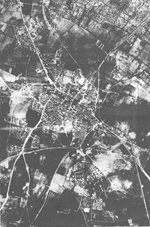 AERIAL PHOTOGRAPH 7.1 © Crown Copyright/MOD Ramleh, one of 13 depopulated towns. Together with its twin, Lydda, their inhabitants, numbering 60,000, have been expelled by the direct orders of Rabin on 11 July 1948. They were forced to march in the searing heat, children and old men falling by the wayside. Under heavy Jewish mortar bombardment, Haifa and Jaffia inhabitants left in overloaded small boats, amid screams and search for lost family members. Many of the boats sank.
AERIAL PHOTOGRAPH 7.1 © Crown Copyright/MOD Ramleh, one of 13 depopulated towns. Together with its twin, Lydda, their inhabitants, numbering 60,000, have been expelled by the direct orders of Rabin on 11 July 1948. They were forced to march in the searing heat, children and old men falling by the wayside. Under heavy Jewish mortar bombardment, Haifa and Jaffia inhabitants left in overloaded small boats, amid screams and search for lost family members. Many of the boats sank.
-
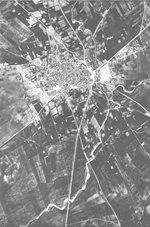 AERIAL PHOTOGRAPH 7.2 © Crown Copyright/MOD Bureir, one of 419 depopulated villages. Bureir was occupied before the entry of the Arab regular forces and was the scene of a massacre on 12 May 1948.
AERIAL PHOTOGRAPH 7.2 © Crown Copyright/MOD Bureir, one of 419 depopulated villages. Bureir was occupied before the entry of the Arab regular forces and was the scene of a massacre on 12 May 1948.
-
 AERIAL PHOTOGRAPH 7.3 © Crown Copyright/MOD AI Ma'in, one of 99 tribal lands (14 May 1948). Although in the Negev, it was fully cultivated, as can be seen. Total cultivated land in Beer Sheba was greater than it is today. Negev is underpopulated today.
AERIAL PHOTOGRAPH 7.3 © Crown Copyright/MOD AI Ma'in, one of 99 tribal lands (14 May 1948). Although in the Negev, it was fully cultivated, as can be seen. Total cultivated land in Beer Sheba was greater than it is today. Negev is underpopulated today.
-
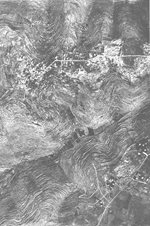 AERIAL PHOTOGRAPH 7.4 © Crown Copyright/MOD Deir Yassin, one of 419 fully depopulated villages, in addition to the refugees from 662 secondary localities. Deir Yassin was the site of the infamous massacre on 9 April 1948. Twenty-five massacres were committed during the expulsion of the Palestinians in 1948.
AERIAL PHOTOGRAPH 7.4 © Crown Copyright/MOD Deir Yassin, one of 419 fully depopulated villages, in addition to the refugees from 662 secondary localities. Deir Yassin was the site of the infamous massacre on 9 April 1948. Twenty-five massacres were committed during the expulsion of the Palestinians in 1948.
-
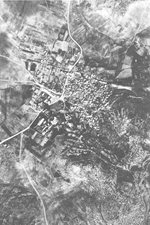 AERIAL PHOTOGRAPH 7.5 © Crown Copyright/MOD Emmaus, mentioned in the Gospel of St Luke as the place where Jesus appeared after the crucifixion. Emmaus was destroyed and the inhabitants were expelled on Rabin's orders in 1967, in continuation of the 'Transfer' policy followed since 1948.
AERIAL PHOTOGRAPH 7.5 © Crown Copyright/MOD Emmaus, mentioned in the Gospel of St Luke as the place where Jesus appeared after the crucifixion. Emmaus was destroyed and the inhabitants were expelled on Rabin's orders in 1967, in continuation of the 'Transfer' policy followed since 1948.
Zureik presented a comprehensive review of resettlement plans and other refugee issues. He describes in particular the semi-official proposal made by SWomo Gazit. Gazit insists on the fmality of the solution, the renunciation of the right of return, the dismantling of UNRWA and the abolition of the special status of refugees. As a reward, Gazit wants Israel to issue a moral-psychological acknowledgement recognising the suffering of the Palestinians over the past 50 years. To avoid admitting Israeli responsibility, this acknowledgement should form part of a UN resolution abolishing the Right of Return enshrined in Resolution-194, paragraph-11.
The Palestinian writer, Ahmed Khalidi, has picked up the thread by suggesting a trade-off between this formal acknowledgement and the admission by the Palestinians that the implementation of the right of return is impossible. However, his has been a lone voice amongst Palestinian refugees which has received no support whatsoever. Arzt, in a much publicised report, suggests the permanent dispersal of the Palestinians through their resettlement wherever they wish, except in their original homes. As a palliative, she also proposes that Palestinians maintain their link as a people by holding some kind of Palestinian identity papers, provided that they drop their claim to their land. In such an event, Israel would be able to retain their land legally.
As an act of generosity, Israel would, however, allow back 75,000 persons, after rigorous vetting and within a limited period. Translated into 1948 figures, this means 8,000 original refugees–a fraction of the 300,000 figure proposed by President Truman in 1949 as a price for admitting Israel into the UN. Finally, Israel was admitted to the UN following the promise made by Moshe Sharett, Israel's representative in the UN, that it would allow the return of 100,000 persons–a promise he never fulfilled.
None of these schemes has had the slightest chance of being accepted by the Palestinians, and alternatives must therefore be found.
The Return Plan
An alternative proposal must counter the common argument that, in practice, Israel is now fully populated and return of the Palestinian refugees is no longer a practical possibility. The proposal outlined below is designed to demonstrate that this fear is unfounded and that the return of the refugees is possible with no appreciable dislocation of Jewish residents.
Israel is divided into 41 "natural regions". [see Map-7.1]
The first eight of these natural regions have an area of 1,683 square kilometres (8 per cent of Israel). This is where the majority of Israelis (2,924,000 or 68 per cent of the Jewish-Israeli population) live–Area A. It is remarkably similar in size, but not exactly in location, to the area in which Jews lived in pre-1948 Palestine. This population concentration emphasises the traditional pattern of Jewish life, in close proximity to one another and in pursuit of occupations such as commerce and industry. Fifty years of Israeli conquest and expansion have not convinced the majority of Israelis to abandon traditional habits. The next five natural regions–Area B–have an area of 1,318 square kilometres (7 per cent of Israel) in which 419,000 Israelis (10 per cent of the Jewish population) live. By coincidence, the size of this area is close to that of the land of the Palestinians who remained in Israel. In short, 78 per cent of Jewish-Israelis in Israel live on 15 per cent of the land area. This leaves Area C (17,325 square kilometres, 85 per cent of Israel). This area is remarkably similar in size and location, but not exactly identical, to the land from which the Palestinian refugees were driven. Who lives there now? About 800,000 urban Israeli Jews, 154,000 rural Israeli Jews and 465,000 Israeli Palestinians. In effect, 154,000 Israeli Jews cultivate the land of 4,476,000 refugees who are prevented from returning to it. In the proposed return plan, refugees will be able to return to their original homes in the majority of cases, or to be relocated close to their original homes in most other cases. The original Palestine sub-district boundaries are close to those used by Israel today; namely Safad, Tiberias, Nazareth, Baysan, Acre, Haifa, Jaffa, Gaza, Ramleh and Beer Sheba. The largest differences occur in sub-districts that were divided by the 1949 Armistice Line. It will therefore be possible to relate the refugees' return to Israel's own administrative districts. In the large Beer Sheba sub-district, refugees would be distributed in the plan according to their original population density–high in the north and low in the south. With the return of the refugees, the overall population density will be 482 persons per square kilometre, instead of the present level of 261 persons per square kilometre, which is still an acceptable figure. The figure should also be compared with current levels of population density in areas under the control of the Palestine National Authority (PNA). The present population density in the Gaza Strip is 4,400 and in the West Bank 880 persons per square kilometre. In the return plan (see Table-7.1), Area A will remain largely Jewish (76 per cent Jews), Area B will be mixed, and Area C will be largely Palestinian (81 per cent).
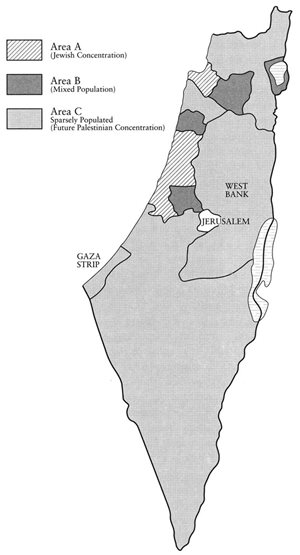 MAP-7.1: Population Concentration in the Proposed Return Plan
MAP-7.1: Population Concentration in the Proposed Return Plan
Some practical adjustments, however, would be desirable. In the densely populated Area A, rural Palestinians (about 900,000) should be relocated to Areas B and C. Conversely, 154,000 rural Jews should be relocated from Area C to Area A, after their leases end, to allow Palestinian farmers to recover their land. This disparity in the numbers of the relocated population, although unfair to Palestinians, is advisable in that it would enhance the homogeneity of population. Given the special status of Jerusalem, no relocation would be applied.
With the return of the refugees, the population density in the Jewish Area A will change only slightly, while it would increase threefold in the Palestinian Area C, to 246 compared to the present 82 persons per square kilometre. Ramleh-Lydda and Khadera areas will have higher population densities, but this would be balanced by merging them into the Triangle, which already has a significant Palestinian population. It is expected that natural population movement and economic forces would eventually lead to a voluntary and more balanced distribution.
A more detailed examination of the Southern District (the Palestinian Gaza and Beer Sheba sub-districts) shows that only 78,000 rural Jews live in 14,107 square kilometres. Their relocation to the north, if they wish, should not cause any hardship. Of the remaining 555,000 urban Jews, 63 per cent live in three Palestinian towns -Beer Sheba, Ashdod and Majdal-Ashqelon and a further 24 per cent live in three new towns–Qiryat Gat (Iraq Manshiya), Elat (Urn Rashrash) and Dimona (Rujm el Belewi). The activities carried out in these towns–shipping, transport, industry and education–are beneficial to the district and should continue. It is ironic that these new towns, with populations ranging from 26,000 to 42,000, are equivalent in size to, or smaller than, a typical refugee camp such as Jabaliya Camp in Gaza, which has a population of 40,000. In short, the return of the Palestinians to their land and the pursuit of their traditional occupation in agriculture should not cause major disruption, either to the Jewish-Israeli population or to their economic activities.
In the Northern District (3,325 square kilometres) there is a similar pattern, although not so clear cut. Of 134,000 rural Jews, only 76,000 would need to be offered voluntary relocation. Urban Jewish residents in the district form 71 per cent of the total Jewish population. About 90 per cent of them live in just nine towns, three of which were originally Palestinian (Acre, Tiberias, Shefa Amr). The largest town in the district (Nazareth, population 54,000) is today totally Palestinian. Apart from Nazareth, the remaining towns are, once again, similar in size to a typical refugee camp.
Although Haifa and the Central districts are densely populated Jewish areas, the presence of Palestinians in these districts is significant, forming 26 per cent and 9 per cent of the number of Jews in each district respectively. In these districts, there are 13 purely Palestinian towns, each with a population in excess of 10,000.
What is clear from these figures is that there is already a substantial Palestinian presence throughout Israel. Thus, the return of the refugees would not be a novelty, nor as catastrophic as some suggest. Although the relationship between the two peoples has not been easy in the past, the fact is that Palestinians and Jews have lived together for the last 50 years without major problems–not to mention the centuries of Arab and Jewish harmony before Zionism appeared in Palestine. The return of the refugees would be consistent with existing concentrations of Jews and Palestinians in contemporary Israel and with their respective occupation patterns. The return would not cause significant dislocation of the Jewish population, for there would be minor voluntary relocation.
The proposed plan represents a maximalist scenario in which all refugees return and all Jewish Israelis stay. Palestinians must have the right to return, whether they actually return or not. Israel gave Jews everywhere the right to come to live in Israel, but only one-third of world Jewry have exercised this option. Many who do, eventually emigrate (17 to 20 per cent). But even in the maximalist case, only 154,000 Jews would face relocation elsewhere in Israel to allow 4,476,000 refugees to return to their homes. This is a very small concession to achieve real peace and to end a state of hostility that has existed for 50 years.
Agriculture and the Palestinian Return
One of the main tenets of Zionism was the return to the land–the abandonment of traditional occupations in finance and commerce in order to become farmers. Communal colonies, the kibbutzim, were set up in pre-1948 Palestine to turn the vision into practice and their members formed the Zionist elite and the backbone of Israel's army. They enjoyed political dominance and unparalleled advantages. Post-1948 immigrants rejected the Zionist agrarian vision. Although they were given land, many of the new farmers drifted to the urban environment. In the 1980s, agricultural labour decreased from 6.4 per cent to 4.7 per cent of the labour force, as agriculture itself faced economic crisis. Dozens of agricultural projects were abandoned, for only 26 per cent of kibbutzim were viable, using 60 per cent of all irrigation water and land, and producing 75 per cent of all production. One problem was that three-quarters of the rural population did not engage in agriculture. Even in the Negev, the Zionist dream of making the desert bloom with consequent major population settlement did not materialise. In 1987, the Jewish rural population in the central and southern Negev was only 7,000, while that in the more fertile northern Negev was just 25,000. These figures did not change, since outward migration balanced the newcomers.
The contribution of agriculture to Israel's GDP decreased from 7.9 per cent in 1983 to 2.4 per cent in 1993. Today it accounts for only 4 per cent of exports as Israel's economy moves towards industrialised manufactured exports instead of continuing its traditional dependence on agricultural exports. To increase the economic value of agricultural exports, Israel plans to reduce the area of low-value crops such as cotton, citrus, avocado and wheat, in favour of speciality crops such as flowers, spices and herbs.
The Palestinians, however, have been farmers for centuries. As successive British government reports during the Mandate show, every possible plot of land was cultivated. In the south, wheat was extensively grown where annual rainfall was just above 200 mm, and barley when the rainfall was above 100 mm. Productivity was low because of the subsistence nature of the agricultural sector and because of a lack of capital. The system is still viable today–Gazan agricultural exports compete in price with comparable Israeli produce. It would thus contribute effectively to the overall economy if the refugees were to return and resume their traditional activities.
Water: the Key to Resettlement
If the country's population were to be doubled through the process of return, water resources in Israel might come under pressure. Israel has in the past used about 80 per cent of the water resources it controls for agriculture, although this proportion is now falling. More important is the issue of cost, for water for agricultural use has been heavily subsidised. Subsidised water, at between 5.85 and 12.5 cents per cubic metre (compared to 50 cents for domestic use), was provided for agricultural use. The average cost of water provision was between 30 and 36 cents per cubic metre, while for arid areas, desalination costs run as high as $1.6 per cubic metre–16 times the costs to the Israeli farmer. Moreover, this exploitation of resources is far in excess of safe yield limits. Serious undermining of aquifers has been observed in the Coastal Plain and near Tiberias. Fresh water from Yarmouk is pumped into Lake Tiberias, thus rendering the water of the lower Jordan River, which is accessible to Jordan as well, unsuitable for irrigation. The salinity of Gaza water is responsible for declining levels of agricultural output, and water pollution has caused widespread health problems. The issue of water access has been a factor in the 1967 War and the 1982 invasion of Lebanon, and has been seen as a potential source of future confuct. Water consumption in Israel grew from 350 million cubic metres per year in 1948 to 1,000 million cubic metres per year in 1956. By 1990, consumption had increased to 2,020 million cubic metres per year, of which 1,471 million cubic metres per year was water taken from sources located in Arab territory. In the next 20 years, Israel plans to increase its consumption to 3,000 million cubic metres per year, despite the danger of conflict that this might provoke. It is clear that a regional agreement over water use will be necessary if conflict is to be avoided, and this would also have to form part of any Palestinian resettlement plan.
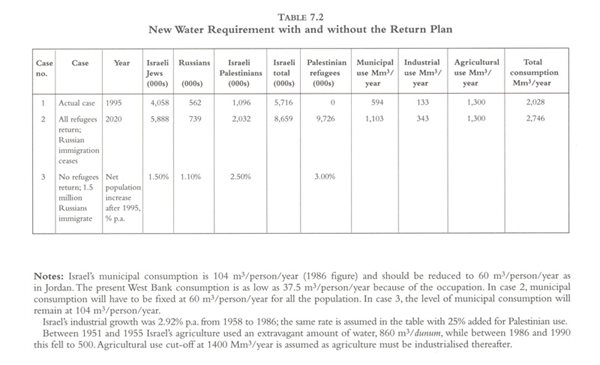
If agricultural consumption is maintained at 1,300 million cubic metres per year, two additional future scenarios emerge. In the first, all Palestinian refugees return, but Russian immigration ceases and municipal use is fixed at 60 cubic metres per person, per year for all the population. In the second scenario, no refugees return and an additional 1.5 million Russians emigrate to Israel, with Israeli municipal water use remaining at 104 cubic metres per person, per year. Both scenarios require roughly the same amount of water, about 2,700 million cubic metres per year, which is the maximum amount of water which may be extracted for Israel/Palestine from its territory and the immediately adjacent region.
The first of these scenarios would be feasible through regional agreement for water resource use. This would allow the refugees to return, although agricultural water use would have to be cut back to meet WHO standards of supply. Case 3 is not possible without a new war to acquire more Arab land and water and, at the same time, a policy of keeping the refugees away from their homes. The consequences of either allowing the refugees to return or admitting more Russians are therefore obvious. There are no water resources available at present for both cases. The second will not be politically acceptable to Israel's neighbours, whose cooperation will be essential if Israel is to acquire access to sufficient water without renewed hostilities. A solution to the refugees' problem will be vital if the coming water crisis is to be resolved, and Israel will therefore have to contemplate modifying its own immigration policies, particularly towards Russia. If, however, Israel continues to insist on the sole control of land and water and to plan for expansion (on the belligerent principle that water cannot be a consequence of peace while in fact it is a condition for peace),34 then true peace seems impossible to achieve. The key to any solution will be the unrestricted return of Palestinian refugees.
Return in Practice
The problems of the logistics of return are not insuperable. After all, between 1949 and 1951, Israel admitted over 650,000 Jews during a period of ongoing hostilities. In the 1990s, Israel admitted a similar number of Russian Jews without any noticeable disruption. The vast majority of Palestinian refugees, furthermore, are close at hand–in Lebanon, Syria and Jordan, or in Gaza and the West Bank. They know where to go; their village sites are mostly vacant. They know who they are; a typical village consists of four to five hamulas (extended families) which are still intact. Complete records of about 700,000 families and five million individual flies still exist, and the construction of new homes could be achieved in record time. UNRWA has a wealth of experience in this regard and is run by a Palestinian staff of 21,000. Thousands of qualified Palestinian workers, engineers and planners have similar experience. The task of reconstruction and rehabilitation is in principle quite manageable; for instance, the logistical exercise for Operation Desert Storm in 1990 ensured that half a million soldiers were moved, fed and housed in a matter of a few weeks.
Protection of Property Rights
To protect the property rights of refugees during the transitional period of refugee resettlement, it will be necessary to form a Palestine land authority (PLA). This will have a mandate to represent the property rights of Palestinians wherever they may be; to document, recover, hold, protect, maintain and develop Palestinian property and act as custodian of all Palestinian property, until individual owners are determined and property is returned to them. The PLA would be an independent authority, cooperating with the Palestine National Council (PNC) and relevant UN or other agencies, which should remain in existence until all its functions have been fulfilled. It would be democratically controlled by a general assembly to consist of approximately 1,500 members, representing 532 depopulated localities, at the rate of three persons per locality. These representatives could be elected or appointed from mukhtars, chief landowners and leading personalities. The total area of Palestinian land in question would be the sum of village and town lands, including common and public land minus land under Jewish ownership in 1948. The latter is very well-defined, as Zionist immigrants and corporations insisted on proof of land purchased or acquired in Palestine.
Initially, village land would be held collectively, through the PLA, in the form of shares assigned to each village. The areas of village lands are well-defined and the total land owned by each village is therefore indisputable. The village unit, with its monolithic, historical, cultural and blood-ties continuity, remains the best instrument for repatriation and rehabilitation. Individual ownership would then be assigned. The UN Conciliation Commission for Palestine (CCP) has 450,000 records of registered individual ownership. These records, however, represent only 5,194 square kilometres out of the total of 17,178 square kilometres of Palestinian refugee land. The balance was unregistered as a result of the hasty departure of the Mandate government, but its ownership was recognised. Custom and inheritance laws may be applied for these cases within the context of the village unit. The legal transfer of property held by Israeli bodies is straightforward. The 49-year land leases held by the kibbutzim are due to expire in 1998. The deeds can be transferred to the legal owners through the PLA by the Israeli Custodian of Absentee Property. The Israeli Development Authority will then become redundant and the Israel Land Administration should hand over the documentation. There should be no cases of dispute between individual Jews and Palestinians, since practically all Jews who have benefited from Palestinian land since 1948 have no personal title deeds. UNRWA would continue to function until all refugees were adequately and safely repatriated. UNRWA would then turn into a development authority under the United Nations Development Programme (UNDP). The return plan would be carried out under the guardianship of the CCP, which would ensure the physical and legal well-being of the returnees. All returning Palestinians would be issued with certificates of Palestinian Identity–converted from the present UNRWA refugee IDs, together with new certificates for about 1,241,000 (1994) refugees who are not registered- in addition to, and regardless of, any other citizenship (including Israeli) they may have. They would enjoy full civil and religious rights within Israel, although their political rights would depend on their country of citizenship. They would, however, have the right to obtain citizenship without discrimination on any grounds.
The Future
The proposed plan of return certainly runs counter to schemes of resettlement preferred by Israel. It is, however, in line with the rights and wishes of five million refugees whose voice is rarely heard. It is abundantly clear that, of the parties in the Arab-Israeli conflict, Palestinians are the only ones who have nowhere else to go, or that they wish to go, except to Palestine. Demographically, their return would cause minimal voluntary relocation of Israelis and no transfer of populations. It could be done, and would inevitably contribute towards permanent peace.
The Palestinians have no moral or legal obligation to accommodate Israelis at their own expense. By any standards, Israel has such an obligation–to correct the monumental injustice it has committed. Yet, the refugees' return has no implications for Israel's sovereignty. It has nothing to do with whether the Oslo Accords succeed or fail. It has nothing to do with settlements, boundaries, or even Jerusalem. The problems facing the proposal are, of course, clear. Israel will not allow it, at least at present, and can prevent it from taking place. Israel's justification for this denial would be the need to protect its security and preserve its nature as a Jewish state.
However, Israeli Palestinians comprise 18 per cent of the population of Israel and 45 per cent of them are less than 20 years old, compared with 29 per cent of the Jewish population. This young community will eventually become a majority within the state if present trends continue–perhaps even within the next two decades. Israel would then have little choice but to accept them as full members of its polity, since subjugation or transfer would no longer be an internationally acceptable option. In that case, Israelis should, perhaps, face realicy and accept full partnership with Palestinians by allowing the refugees to return. It is the inevitable, democratic solution, even if it overturns the assumptions of Zionism which have ruled Israel for the past 50 years. Many Israelis themselves are already questioning the usefulness of Zionism in the fragmented mosaic that is Israel today.